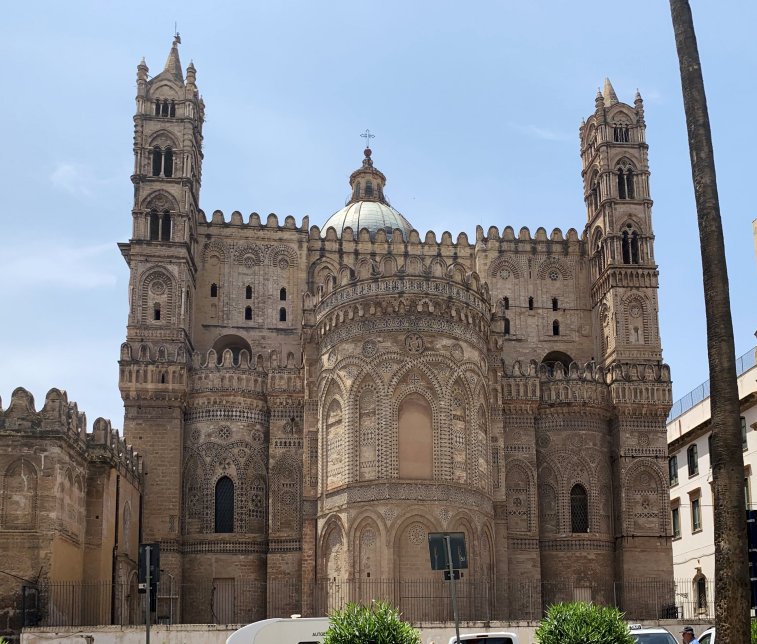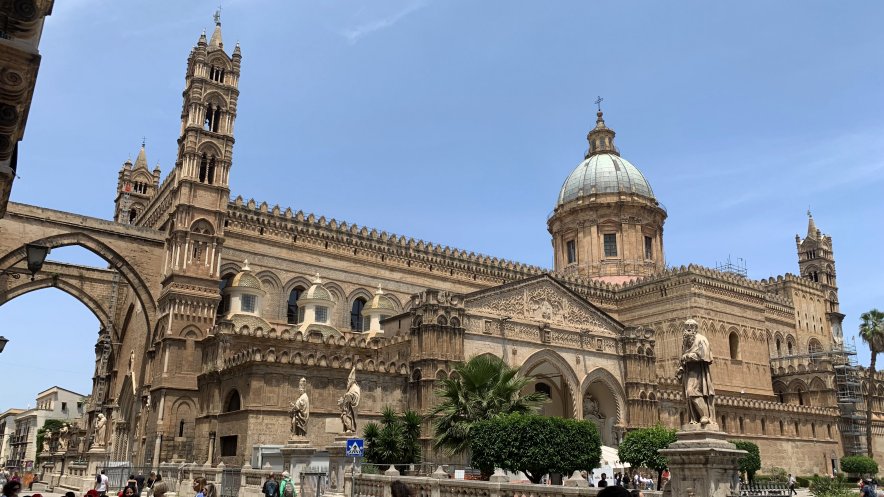Palermo Cathedral
The cathedral was allegedly founded by Pope Gregory
(d.604) during the period of Byzantine rule of the city (535-831). In
1072 when the Normans arrived, Palermo was the only Christian see in
Sicily, although 5 more were created in the period 1081 to 1093.
In 1131 Messina was raised to be an archbishopric and Cefalu and
Lipari were made new bishoprics under it.
However this new reorganisation was not recognised by Rome as it
was undertaken with the blessing of the antipope, Anaclectus (d.1138).
The basis of the present Palermo cathedral structure
is said to date from the last years of Archbishop Walter Ophamil (d.1191)
who
is thought to have rebuilt the Arab mosque which lay on the ancient
Byzantine basilica site. Walter was long thought to have been an
Englishman, Ophamil being a
corruption of the English 'of the mill'. However, more modern
scholarship has shown that Ophamil was not a surname, but a contraction
of protofamilaris, first of the king's familiars, ie. prime minister. This seems a similar misconception to that of the earl of Pembroke being given the English nickname of Strongbow.
As Ophamil's mother, Bona, was a patron of Cluny abbey, it seems
likely that he came from what is now France. According to Peter
of Blois he was of humble birth. He became archbishop in 1168,
after the deposition of Archbishop Stephen Perche (d.1169), through the
support of the Queen Mother and even Thomas Becket (d.1170), the
dispossessed archbishop of Canterbury.
He was consecrated in the cathedral on 28 September 1168.
When the first archbishop of Monreale was consecrated in 1176, to
augment the religious power of King William II (d.1189), Walter is said
to have commenced rebuilding Palermo cathedral so that it was not
overshadowed by the extravagant new Monreale cathedral. On
William II's death in 1189, Walter supported the Emperor Henry's
succession, but bowed to the pope's request to crown King Tancred
(d.1194) in his cathedral in January 1190. Walter died the next
year and was buried in Palermo cathedral crypt.
The cathedral was heavily rebuilt from the fourteenth century onwards
and now, after major rebuilding after an earthquake, has a neoclassical
appearance which was designed in the last decades of the eighteenth
century to be a mixture of Norman and Arabic.
 Description
Description
The cathedral
has a Byzantine plan with 3 apses, which are claimed to be the work of
Archbishop Walter Ophamil (d.1191). Of this the apses alone and the crypt are said to be his work. The
exterior of the apses have been heavily refaced in Arabesque,
apparently in imitation of Montreale, while the interior is totally
Baroque. The highpoint of this is the major roundel to the east
containing the two headed Eagle of the Hohenstaufens. Of the
rest, little remains with certainty of the early
church which was heavily rebuilt in the late Middle Ages.
To the south is a wide main entrance built in the mid fifteenth
century, but including a column from the original Byzantine basilica as
its westernmost column. This still has a quote from the Qur'an
carved into it. Internally, above the door, the reset mosaic of
the Madonna appears thirteenth century. In the choir is a
polychrome crucifix donated by Manfred Chiaramonte (d.1321) of Caccamo.
The church interior is now Baroque and compares badly with the
medieval interior of Montreale which may give an inkling of what it
was originally like.
In the eighteenth century the tombs of the rulers of Sicily were placed
in chapels off the aisle. In the Loggia dell'Incoronata lie King Roger (d.1154) and his daughter Constance (d.1198), brought here from Cefalu. With them lie the Emperors Henry VI (d.1197), Frederick II
(d.1250) and the latter's queen, Constance Aragon. When her
sarcophagus was opened in 1781 various grave objects were found
inside. One of these was her crown, richly decorated with strings
of pearls and precious stones. It is probably the same one with
which Frederick II
was crowned emperor by Pope Honorius III in 1220. On her death 2
years later it is presumed that Frederick had it placed in her tomb.
There are also tombs from
the Roman to Byzantine period, while Archbishop Walter (d.1191) is
buried in a sarcophagus in the crypt. Unfortunately there is no
tomb for Bishop Odo of Bayeux, the half brother of William the Conqueror and one time lord of Leeds castle in Kent, who was buried in the cathedral in 1097.
Why not join me here and at other Sicilian churches?
Information on this and other tours can be found at Scholarly
Sojourns.
Copyright©2019
Paul Martin Remfry


 Description
Description